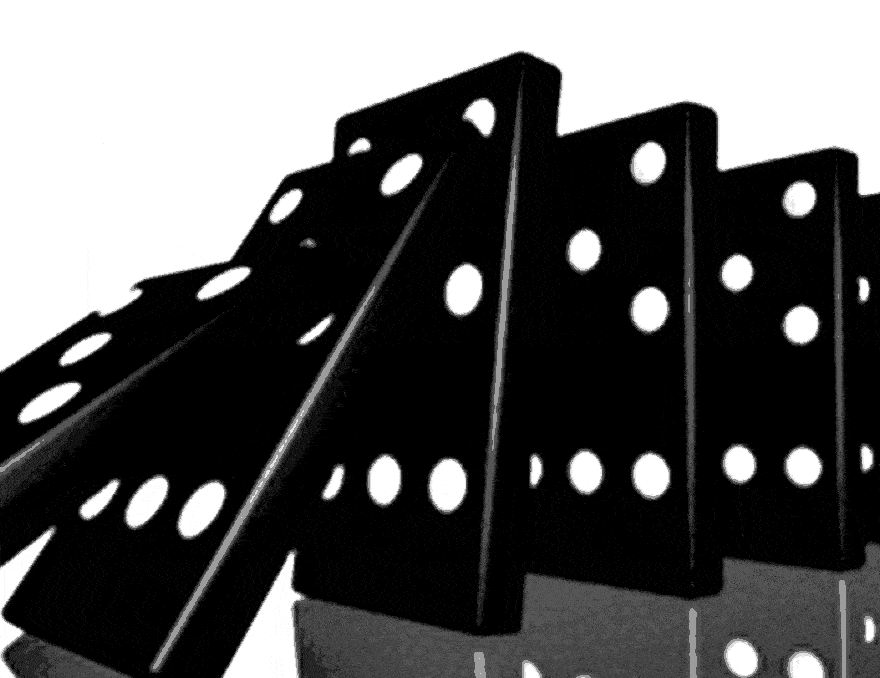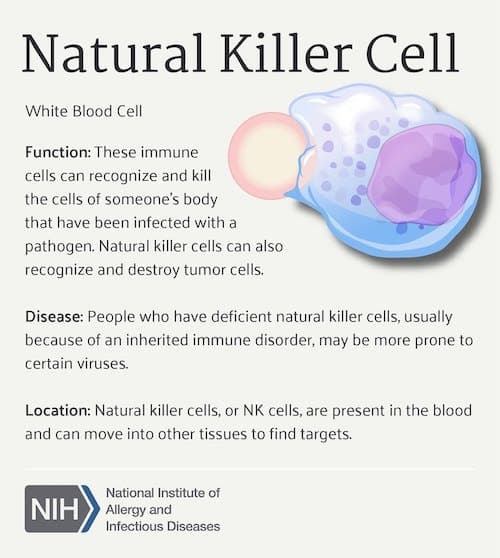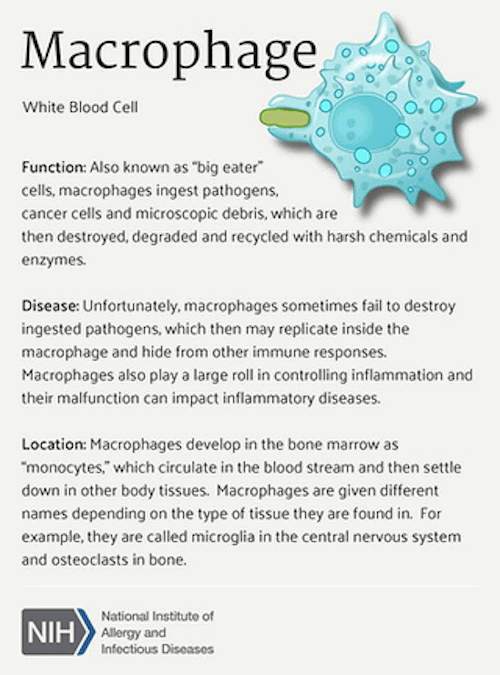Lesson 12: Wildcard Part II: The SARS-CoV-2 Domino Effect
Lesson 12 Protocol 3
Understand how a SARS-CoV-2 infection can create a domino effect where each compromised immune response to the virus reduces the ability of subsequent immune responses to be effective.
A SARS-CoV-2 infection can impair your immune system by creating a downstream dysregulation of your immune system’s normal response in viral infection.
Much of this dysregulation has to do with:
- The inability for natural killer cells to properly signal other immune cells, such as macrophage and dendritic cell;
- The inability to identify antigens so that immune cells of the adaptive system can target infected cells; and
- An imbalance between T-1 and T-2 helper cells, whereby Th-2 cytokines diminish the Th-1response, and blunt the overall efficiency of the antiviral immune response.
It’s important that the Th-2 response is not dominant, something that can occur should you have issues with sleep disruption, cortisol, GI inflammation or asthma.
There are nutraceuticals that can help support natural killer cells and Th-1 activation, while blunting Th-2 dominance, which is the focus of Lesson 13.
Wildcard Part II: The SARS-CoV-2 Domino Effect
Way back in Lesson 2 you got a sense of how this virus can disrupt the normal and expected immune response to a pathogen, such as a virus. In this lesson we’ll go deeper into the challenges made by SARS-CoV-2 to our immune system.
As you know by now, this virus has a novel way of disrupting the immune response. The better you understand how that happens, the more confidence you’ll have in the Protocols.
Let’s begin our deep dive into how SARS-CoV-2 can upend your immune response. A metaphor we can use is dominos. The domino effect occurs when the first responders of the innate immune system are compromised by SARS-CoV-2.
The dominos start falling when:
- Natural killer cells are unable to signal other immune cells, such as macrophage and dendritic cells. (Domino 1)
- Antigens can’t be identified and activate a proper immune response led by T cells. (Domino 2)
- There’s an imbalance between Th-1 and Th-2 helper cells, where Th-2 is dominant. (Domino 3)
Let’s dig into the reasons why we want to support natural killer cells and Type-1 helper cells, while at the same time minimizing the potential for Type-2 helper cell overreaction to Covid.
Natural Killer Cells Drive The Immune Response
Natural killer cells drive the core immunological response to viral infection. [1]
Natural killer cells are lymphocytes, which are white blood cells. They’re in the same family as T and B cells, and are part of the innate immune system. We rely on the innate system to recruit immune cells to sites of infection through cytokine signaling.
You will recall from our review of the immune system in Module 1, that natural killer cells got that “killer” name, because they have the ability to kill tumour cells and pathogens without any priming or prior activation, such as by antigen presenting cells.
Remember, antigen presenting cells are immune cells that stimulate your immune system to produce antibodies against pathogens so they can be recognized and destroyed by certain lymphocytes such as T cells.
In addition to killing pathogens, natural killer cells secrete cytokines like interferon gamma, and other cytokines, which act on other immune cells like macrophage and dendritic cells in order to enhance the immune response.
Macrophages Activation Delayed
Recall that macrophages are specialized cells that help detect and destroy pathogens, like a virus. This happens when macrophages ingest or engulf other cells or particles like a virus (called “phagocytosis”).
The SARS-CoV-2 virus can delay macrophage activation, and can infect and kill them. [2,3]
You don’t want this to happen.
The ability to delay the innate immune response by blunting the effectiveness of macrophages is thought to be one reason that a person can get infected with SARS-CoV-2 two to 14 days before the onset of symptoms.
This can happen if macrophages aren’t quickly activated once the virus enters a cell. If not activated, macrophages cannot engulf and digest a virus, and they cannot destroy the virus by presenting antigens to T cells.
Antigens are those molecules that if present at the outside of a virus can be bound to by an antigen-specific antibody, which are those proteins with special receptors that allow them to identify, bind to and neutralize antigens.
If antigens are not presented to T cells, the T cells cannot initiate an inflammatory response by releasing those signaling molecules called cytokines that I keep talking about that activate other immune cells.
Initially, after infection, you want and need an inflammatory response. Inflammation is a natural response of your immune system that helps isolate a foreign substance, like a virus, from further infecting cells or tissues. Inflammation chemicals also activate those macrophages.
But as you’ll see later on in Protocol 4, inflammation can get out of hand and become a big problem, especially with Covid.
Now let’s look at dendritic cells (DCs).
Dendritic Cells, The Adaptive Immune Initiator
Dendritic cells are named for their probing, ‘tree-like’ or dendritic shapes. They’re responsible for the initiation of adaptive immune responses, given that they’re specialized to capture and process antigens. In that capacity, they function as the ‘sentinels’ of the immune system.
Let me say again, phrased a bit differently, that dendritic cells provide crucial stimulation signals to other cells that can attack the virus.
Antigen presentation is a process in the body's immune system by which macrophages, dendritic cells and other cell types capture antigens. Then these antigen-possessed virions, virus particles, are then presented to naive T-cells.
These naive T-cells come from the bone marrow and develop in the thymus -- which is why they’re called “T” cells -- but naive T-cells are naive, or immature, until presented with an antigen, say by a dendritic cell. When that happens, the T-cells mature. Having found their mission in life, they make copies of themselves and kill infected cells.
The point of me going through all this with you is to underscore that if macrophages and dendritic cells don’t identify and mark virions with an antigen that marks it for destruction by various cells of the adaptive immune system, then your immune system doesn’t learn about, or adapt to, the pathogens it needs to destroy and build immunity against, which is role of the adaptive immune system and why it exists.
This is a problem that SARS-CoV-2 infection creates. It can destroy macrophages and dendritic cells before they can initiate effective antigen presentation to activate the adaptive immune system.
The higher the viral load -- meaning the more virus you have in you -- the more macrophages and dendritic cells will be destroyed by the virus, leading to a greater inhibition of the needed immune activation necessary to get ahead of the virus.
The Need For A Balanced Immune Response
Of course, those exposed to high viral loads have a greater risk of severe disease. What’s needed, then, is support for the efficient activation of the innate immune system, both before at-risk individuals are infected, and as an early phase intervention for those infected.
This is a high wire balancing act, because every immune response against pathogens, like viruses, causes an incremental increase in inflammatory cytokine activation.
A little bit is OK, even necessary. Too much can put you in danger of severe illness, which is what the cytokine storm is all about.
You can think of this as an inflammatory loop where the greater the immune response to the virus is, the more inflammation is created, unless the signaling chemistry of the inflammatory process resolves the problem by killing off the virus.
If the virus isn’t killed off, unbridled inflammation can happen. This creates a lot of free radicals and oxidative stress which all together can drive fatality in COVID-19 disease, characterized by cytokine storm, acute respiratory disease syndrome, septic shock, organ failure, and other factors associated with failure to control inflammation. [4]
What this all distills down to is that you don’t want an overwhelmingly strong immune response to SARS-CoV-2, but instead you want a modulated one, a refined one… just the right amount of inflammation in the native immune system to effectively signal the adaptive immune system to get going.
Upregulate Interferon Gamma and Interleukin 12
Now, given how SARS-CoV-2 can disrupt the immune system, the key question is how to prevent this from happening? The answer is that we must support the various immune cells that can be compromised when facing a SARS-CoV-2 assault.
Specifically, what we need to do is to upregulate two cytokines: interferon gamma and interleukin 12.
Here’s what’s useful to know about interferon gamma:
- Interferon gamma is a type of interferon. Interferons are cytokines made by natural killer and Th-1 cells that are involved in intercellular signaling. Interferon gamma is the main Th-1 cytokine.
- Interferons got their name because they "interfere" with viruses. They tell your immune system that pathogens are in your body, and they trigger killer immune cells to fight those invaders and keep them from multiplying.
- Interferon gamma activates macrophages and stimulates them to more rapidly and fully destroy pathogens they have engulfed and destroyed (phagocytosed).
Here’s what’s useful to know about interleukin 12:
- Interleukin 12 is an interleukin that is naturally produced by dendritic cells, B cells, macrophages and neutrophils in response to an immune response stimulated by an antigen (antigenic stimulation).
- Interleukins are a group of cytokines expressed by white blood cells. They mediate communication between cells, and are particularly important in stimulating immune responses, such as inflammation.
- Interleukin 12 is an important regulator of Th-1 helper responses. It also promotes the expansion and survival of activated T-cells and natural killer cells, as well as other immune cells.
Should a SARS-CoV-2 infection occur, we want interferon gamma and interleukin 12 to function properly in order for it to support macrophages, natural killer cells, neutrophils and other immune cells.
In order to do their jobs when confronted with SARS-CoV-2, these two cytokines could use a helping hand. Such assistance comes from natural killer cells and Th-1 cells, short for T helper 1 cells
T Helper 1 Cell Activation Needed
You’ve already learned about natural killer cells, and now it’s time to address Th-1 cells.
Like natural killer cells, Th-1 cells also play a key role in antiviral immunity. They interdependently support each other’s activation through self-reinforcing interactions with macrophages. [5,6]
Here’s what’s useful to know about Th-1 cells:
- T helper cells are a type of T cell that activate other immune cells, including killer T cells and B cells, so that these immune cells can identify and destroy pathogens.
- Th-1 cells produce cytokines such as interferon gamma and interleukin 12. This is the reason I’m focusing you on Th-1 cells. They produce the two cytokines that enable cell mediated immunity and the production of antibodies that promote phagocytosis.
- Th-1 cells can also block the production of Th-2 cells. Th-2 dominance is an attribute found in SARS-CoV-2 in patients requiring intensive care.
I’ll return to Th-1 and Th-2 cells in a minute, but first I want to make sure that your takeaway from all this complicated immune system jargon is that several self-reinforcing immune cell interactions are required for a proper immune response to viral infection. If these are disrupted, our immune system will not have a coordinated, modulated response to infections.
Unfortunately, this is what’s happening to some people who get infected with SARS-CoV2, especially those who are over 50 and/or have the comorbidities reviewed in Lesson 10. For them, there’s a discernible risk that macrophages and dendritic cells are being infected and destroyed by the SARS-CoV-2 virus. [7]
Now, this is not unique to SARS-CoV-2. Other viruses can escape from phagosomes after they’re engulfed by macrophages and dendritic cells. But normally when this happens there’s a complex backup system that kills infected cells so a virus can’t use the cell machinery to replicate itself.
However, I repeat that in some people this backup system is not helping out. So, we need another way to push back against the SARS-CoV-2 virus ability to engage in pathogen evasion strategies that delay macrophage responses and destroy macrophages.
One way to do this is to shorten the time period between when macrophages and dendritic cells do their phagocytosis thing, and when the engulfed virions are degraded.
That’s what interferon gamma and interleukin 12 can help do, and is why we want to make sure they’re upregulated by supporting natural killer and Th-1 cells. [8]
But one thing can stand in the way -- T helper 2 cells.
Yes, we’re back to the T helper cells.
Th-1 cytokines tend to produce the proinflammatory responses responsible for killing pathogens, and to balance that out, Th-2 cytokines provide an anti-inflammatory response. [9]
Ideally, these two main branches of T helper cells would be in balance, so that just enough inflammation would be produced to kill most of the virus during the native immune system phase, but not enough to cause a problem, such as a cytokine storm.
In some people, however, there may be Th-2 dominance. This happens when Th-2 cytokines diminish the Th-1 response and blunt the overall efficiency of the antiviral immune response.
In this case, it’s wise to downregulate Th-2 dominance in order to promote an adequate Th-1 response.
So, how do you know if Th-2 dominance is happening to you? You need to find out if you have the symptoms associated with SARS-CoV-2 infection. This is not easy to assess, as many of these symptoms are symptomatic of many other health issues as well, both large and small. To help you identify if your symptoms are related to this novel coronavirus, review the COVID-19 Symptoms document.
Factors That Drive Th-2 Dominance
I think this pandemic has made us hypochondriacs, so unless you can get tested to confirm your suspicion that you have Covid, consider the factors that can drive someone into Th-2 dominance, such as:
- Sleep disruption
- Stress chemistry (cortisol)
- GI tract inflammation
- Asthma
Except for asthma, we covered all of these symptoms of Th-2 dominance in Protocol 2, which is about building up your foundational immunity by reducing baseline inflammation.
If you’re stressed, are not waking up feeling refreshed by your sleep, or experience gastrointestinal issues, then make sure you’re actively implementing the protocols presented in Protocol 2, as well as consuming the nutraceuticals covered in the next lesson, Lesson 13.
If you experience any of these, pay attention to the recommended nutraceuticals covered in Lesson 13, which the scientific literature suggests are able to help support natural killer cells and Th-1 activation, while blunting Th-2 dominance. (People with asthma or allergies are known to be predominantly Th-2 dominant.) [10]
Your Takeaway
A SARS-CoV-2 infection can impair your immune system by creating a downstream dysregulation of your immune system’s normal response in viral infection.
Much of this dysregulation has to do with:
- The inability for natural killer cells to properly signal other immune cells, such as macrophage and dendritic cell;
- The inability to identify antigens so that immune cells of the adaptive system can target infected cells; and
- An imbalance between T-1 and T-2 helper cells, whereby Th-2 cytokines diminish the Th-1response, and blunt the overall efficiency of the antiviral immune response.
It’s important that the Th-2 response is not dominant, something that can occur should you have issues with sleep disruption, cortisol, GI inflammation or asthma.
There are nutraceuticals that can help support natural killer cells and Th-1 activation, while blunting Th-2 dominance, which is the focus of Lesson 13.





Leave a comment
Comment as a guest: